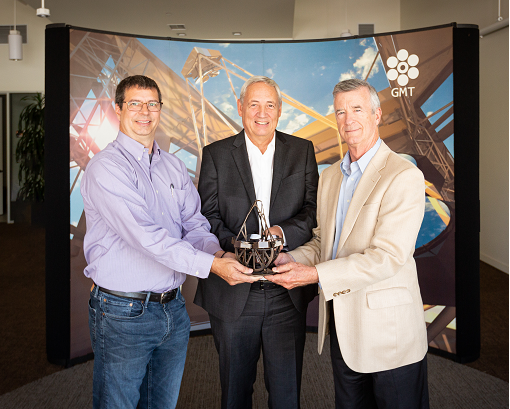THE NEW TELESCOPE WILL HAVE A RESOLVING POWER TEN TIMES GREATER THAN TODAY’S LEADING GLOBAL TELESCOPES
- Ingersoll will produce the huge 1,300 ton precision steel optical support structure which will allow frictionless movement made possible thanks to the Camozzi Group’s highly advanced, globally recognized hydrostatic technology
- In total this is a 135 million dollar investment, the biggest realized to date by GMTO. The contract was won following a 2-year global tendering process. Over the next 9 years GMTO, MT Mechatronics and Ingersoll Machine Tools will work together to deliver the 1,300 ton steel structure, which is due to be delivered to Chile by the end of 2025, ready for mirrors to be installed in 2028.
- The Giant Magellan Telescope (GMT) is the result of the collaboration of 12 of the world’s leading universities and scientific institutes and it is planned to become operational in 2029 following its construction in the Chilean desert. Funding for the project comes from the partner institutions, governments and private donors
- The Giant Magellan Telescope (GMT) will significantly advance our knowledge and understanding of the universe through the study of planets beyond the solar system in the search for signs of life and the study of black holes and dark energy. The GMT will have a resolving power ten times greater than today’s leading global telescopes and could make discoveries that will change the view of our place in the Universe
Lodovico Camozzi, Chairman and Chief Executive Officer of Camozzi Group, stated: “We are delighted that we will be working on the creation of an exclusive scientific and revolutionary system for studying the deep cosmos. The project fills us all in Camozzi with pride and is an inspiration to us. We are also very pleased at having been selected in a tender involving the world’s leading groups”.
30 October 2019 – Brescia – The Italian Group Camozzi, through its fully owned subsidiary Ingersoll Machine Tools headquartered in Rockford (Illinois), has entered into an agreement in conjunction with MT Mechatronics, located in Mainz (Germany) – with GMTO, the organization managing the development of the Giant Magellan Telescope (GMT) on behalf of its US and international founders, to build the telescope’s steel precision structure.
The GMT is a 24.5 meter (80-ft) diameter next-generation giant optical-infrared observatory that will explore the frontiers of astronomy, seeking forms of life beyond our solar system and capable of changing the history of space exploration.
Ingersoll Machine Tools together with MT Mechatronics will design and manufacture the 1,300- ton precision mechanism, known as the “telescope structure” that holds the GMT’s optics which will smoothly track celestial targets as they move across the sky. The telescope will be designed by MT Mechatronics and manufactured, assembled, and tested by Ingersoll before being shipped to, and installed at, the GMT observatory site high in the remote Chilean Andes.
The telescope structure contract will require nine years of effort by a large workforce of engineers, designers,
metal workers, and machinists and have total value of $ 135 million.
“Manufacturing the telescope structure is one of the biggest steps we will take on our journey to building the
Giant Magellan Telescope “, said Dr. Robert N. Shelton, GMTO President.
“We selected Ingersoll Machine Tools and MT Mechatronics for their commitment to quality, extensive experience with astronomical telescopes and abilities to manufacture complex precision structures, following a two-year global competition”, added Dr. James Fanson, GMTO Project Manager.
The structure of the telescope will hold the seven giant mirrors of the GMT in position as they bring the light of distant stars and galaxies into focus so that they can be analyzed by the scientific instrumentation built into the telescope. The mirrors, the largest in the world, have been produced by the Richard F. Caris Mirror Lab of the University of Arizona. The structure of the telescope, complete with mirrors and all instrumentation, will weigh 2,100 tons and will float on a 50 microns thick (2 thousandths of an inch) oil film which will ensure frictionless movement to offset the earth’s rotation and follow the celestial bodies in their paths across the sky. This “hydrostatic” technology was patented several years ago by INNSE, a Camozzi Group company, renowned throughout the world for this technology. With its unique design the GMT will have a resolving power 10 times greater than the Hubble Space Telescope in the infra-red section of the spectrum.
“It will be a special day when the GMT’ telescope structure is completed and placed in service in Chile, as part of one of the most complicated and fascinating projects that the world scientific community has ever undertaken”, said Chip Storie, CEO of Ingersoll Machine Tools.
The contract between GMTO, Ingersoll Machine Tools and MT Mechatronics will involve nine years of work and 1,300 tons of structural steel and the structure is expected to be delivered to Chile at the end of 2025 and be ready to accept mirrors in 2028.
The Giant Magellan Telescope
The Giant Magellan Telescope is a next-generation ground-based telescope that promises to revolutionize our understanding and view of the universe. The GMT is poised to enable breakthrough discoveries in cosmology, the study of black holes, dark matter, dark energy, and the search for life beyond our solar system. The telescope’s primary mirror combines seven 8.4-meter (27 feet) diameter circular segments to form an effective aperture 24.5 meters in diameter. The GMT will be located at Las Campanas Observatory in Chile’s Atacama Desert and the project is the work of a distinguished international consortium of leading universities and science institutions. Funding for the project comes from the partner institutions, governments, and private donors.





